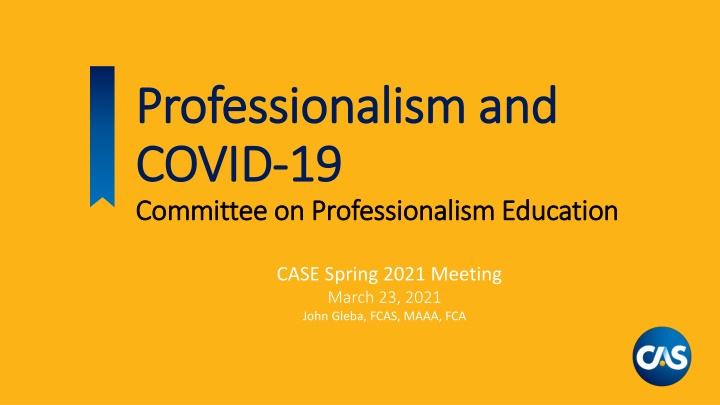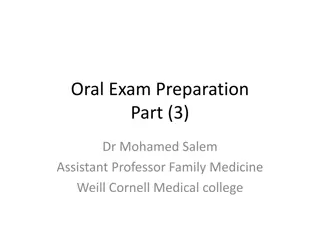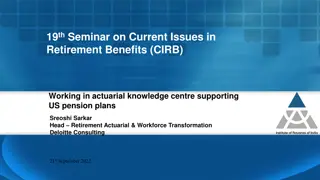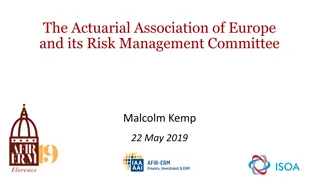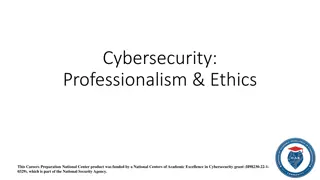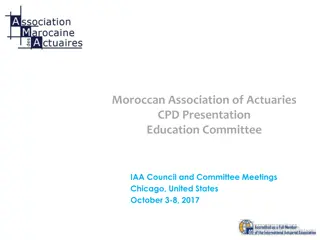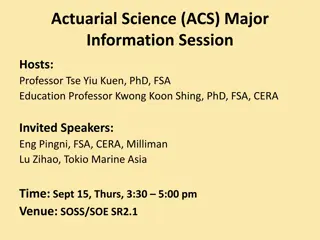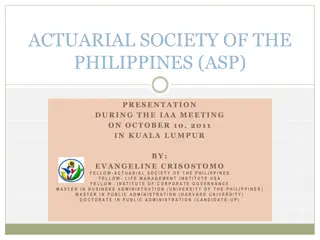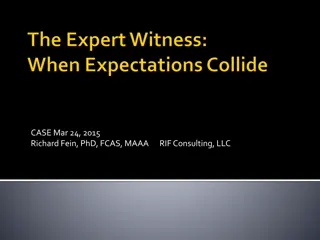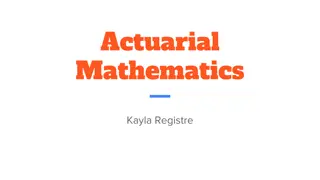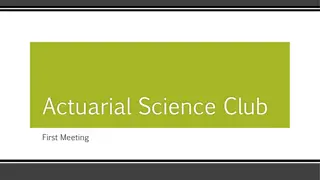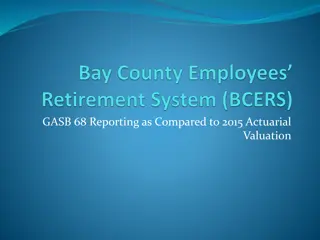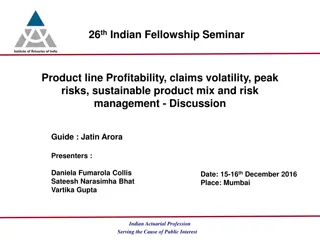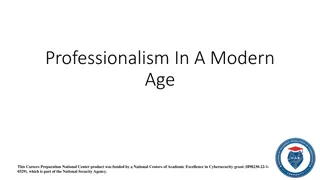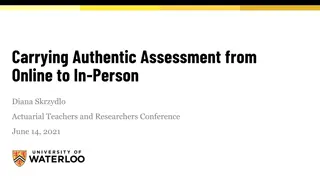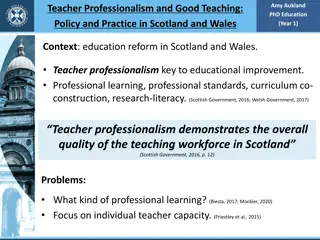Insights on Professionalism, COVID-19, and Actuarial Decisions
Explore key topics discussed in the CAS Spring 2021 meeting, including the impact of COVID-19 on insurance operations, antitrust regulations, legal disclosures, and recent changes in actuarial principles. Discover insights on pandemic-related disruptions, regulatory impacts, and challenges faced by P&C companies in the current environment.
Uploaded on Sep 15, 2024 | 3 Views
Download Presentation

Please find below an Image/Link to download the presentation.
The content on the website is provided AS IS for your information and personal use only. It may not be sold, licensed, or shared on other websites without obtaining consent from the author.If you encounter any issues during the download, it is possible that the publisher has removed the file from their server.
You are allowed to download the files provided on this website for personal or commercial use, subject to the condition that they are used lawfully. All files are the property of their respective owners.
The content on the website is provided AS IS for your information and personal use only. It may not be sold, licensed, or shared on other websites without obtaining consent from the author.
E N D
Presentation Transcript
Professionalism and Professionalism and COVID COVID- -19 19 Committee on Professionalism Education Committee on Professionalism Education CASE Spring 2021 Meeting March 23, 2021 John Gleba, FCAS, MAAA, FCA
Anti-Trust Notice The Casualty Actuarial Society is committed to adhering strictly to the letter and spirit of the antitrust laws. Under no circumstances shall CAS webinars be used as a means for competing companies or firms to reach any understanding expressed or implied that restricts competition or in any way impairs the ability of members to exercise independent business judgment regarding matters affecting competition. It is the responsibility of all webinar participants to be aware of antitrust regulations, to prevent any written or verbal discussions that appear to violate these laws, and to adhere in every respect to the CAS antitrust compliance policy.
Legal Disclosure The views expressed by the panelists are their own and may not necessarily reflect those of their respective employers.
December 22,2020 Repeal of Statement of Principles CAS Board felt that the general principles were already covered in various other ASOP s Push back from NAIC and other consumer groups (Consumer Federation of America), especially related to ratemaking principles Specifically, the requirement that rates be adequate, not excessive, and not unfairly discriminatory which are codified in state regulations. CAS Board continues to discuss & receive feedback
Corona Virus Disruptions: Operations 05 01 What is the impact to the P&C Company ? 02 What is the impact on cash flow ? 03 What about Social Security and Pensions ? 04 How will surplus assets be impacted, both short and long term ? 05 How will policy audits be impacted ? 06 What about reinsurance contracts ? 07 What about the changing laws and regulatory environment ?
Corona Virus Proximate Impacts HEALTH CYBER LIABILITY WORKERS COMPENSATION AUTOMOBILE LIABILITY PROPERTY
We now have (some) data! NAIC Auditors Ongoing Actuarial Opinion Specific Questions More Data
COVID-19 Meets the ASOPs Claims, Cash Flow, Court Hearings Professionalism Documents provide Changing Operations guidance Immediate and Long Term Impacts
ASOP 1 Introductory Standard of Practice
ASOP 1 -Introductory Standard of Practice Section 3. Purpose and Format of Actuarial Standards of Practice 3.1 The Purpose of ASOPs ASOPs identify what should be considered, done, documented, and disclosed when rendering actuarial services.
ASOP 23 Data Quality
Trouble Ahead. Trouble Behind. ASOP 23 (Data Quality) addresses issues caused by changes in data caused by changing conditions. Nobody has definitively determined the impact of the pandemic on insurance company data. Is past data useless for projecting current losses? Is current data useless to protect future losses?
ASOP 23 and COVID-19 Section 2 defines - Review - An examination of the obvious characteristics of data to determine if such data appear reasonable and consistent for purposes of the assignment . Section 3.3- Review of Data If the actuary performs a review, the actuary should do the following: b. make a reasonable effort to identify data values that are questionable or relationships that are significantly inconsistent. If the actuary believes questionable or inconsistent data values could have a significant effect on the analysis, the actuary should consider taking further steps, when practical, to improve the quality of the data.
ASOP 23 and COVID-19 4.1 Communication and Disclosure Such communication should contain the following disclosures when relevant and material: 4.1 e. in summary form, discussions of any significant steps the actuary has taken to improve the data due to identifying questionable data values or relationships, as discussed in section 3.3(b); 4.1 f. in summary form, significant judgmental adjustments or assumptions that the actuary applied to the data or to the results, or are known by the actuary to have been applied to the data, to allow the actuary to perform the analysis, as discussed in section 3.4(c);
ASOP 23 and COVID-19 Sec 3.4 Use of Data Because appropriate data that are accurate and complete may not be available, the actuary should make a professional judgment about which of the following are applicable: If the actuary judges that the use of the data, even with adjustments and assumptions applied, may cause the results to be highly uncertain or contain a significant bias, the actuary may choose to complete the assignment but should disclose the potential existence of the uncertainty or bias, and, if reasonably determinable, the nature and potential magnitude of such uncertainty or bias, in accordance with section 4.1(g). Alternatively, the actuary may compensate for the data deficiencies by adjusting the results, such as by increasing the range of reasonable estimates, and disclose the adjustments, in accordance with section 4.1(f);
ASOP 41 Actuarial Communications
ASOP 41 and COVID-19 3.4.1 Uncertainty or Risk The actuary should consider what cautions regarding possible uncertainty or risk in any results should be included in the actuarial report. For example, If they believe that there has been a slow down in claims reporting and payment, the actuary may well assume that there will be a period of catch up (lasting perhaps several years). The current accident period(s) will likely be under-projected using historical data. What is the actuary to do?
ASOP 41 and COVID-19 3.4.6 Subsequent Events The actuary should disclose any relevant event that meets the following conditions: a. it becomes known to the actuary after the latest information date described in section 3.4.5; b. it becomes known to the actuary before the report is issued; c. it may have a material effect on the actuarial findings if it were reflected in the actuarial findings; and d. it is impractical to revise the report before it is issued.
ASOP 41 and COVID-19 If the actuary learns of changes to data or other information (on or before the information date) after some findings have been communicated, but before the report is completed, the actuary should communicate those changes, and their implications, to any intended user to whom the actuary has communicated findings. Is the catch up period a subsequent event per 3.4.6 c.? Do you already know the NEXT year s review will reveal this subsequent event ?
ASOP 41 and COVID-19 3.5 Explanation of Material Differences If a later actuarial communication produced by the same actuary, which opines on the same issue, includes materially different results or expresses a different opinion from the former communication, then the later communication should make it clear that the earlier results or opinion are no longer valid and explain why they have changed. If the later communication is oral, the actuary should follow-up with a document that clarifies the reason(s) for the changes. If you already know that ultimates will change significantly next year, do you need to disclose the probability of material differences BEFORE they happen?
ASOP 41 and COVID-19 3.7 Responsibility to Other Users An actuarial document may be used in a way that may influence persons who are not intended users. The actuary should recognize the risks of misquotation, misinterpretation, or other misuse of such a document and should take reasonable steps to ensure that the actuarial document is clear and presented fairly. To help prevent misuse, the actuary may include language in the actuarial document that limits its distribution to other users (for example, by stating that it may only be provided to such parties in its entirety or only with the actuary s consent). Shareholders/investors rely on the findings in the report?
ASOP 43 Property/Casualty Unpaid Claim Estimates
ASOP 43 and COVID-19 3.5 Nature of Unpaid Claims The actuary should have an understanding of the nature of the unpaid claims being estimated The actuary need not be familiar with every aspect of potential unpaid claims. Examples of aspects of the unpaid claims (including any material trends and issues associated with such elements) that may require an understanding include the following: b. conditions or circumstances that make a claim more or less likely or the cost more or less severe; c. the underlying claim adjustment process;
ASOP 43 and COVID-19 3.6 Unpaid Claim Estimate Analysis The actuary should consider factors associated with the unpaid claim estimate analysis that, in the actuary s professional judgment, are material and are reasonably foreseeable to the actuary at the time of estimation. The actuary is not expected to become an expert in every aspect of potential unpaid claims.
ASOP 43 and COVID-19 3.6.1 Methods and Models The actuary should consider methods or models for estimating unpaid claims that, in the actuary s professional judgment, are appropriate. The actuary should select specific methods or models, modify such methods or models, or develop new methods or models based on relevant factors including, but not limited to, the following: d. the applicability of various methods or models to the available data; and e. the reasonableness of the assumptions underlying each method or model. The actuary should consider whether, in the actuary s professional judgment, different methods or models should be used for different components of the unpaid claim estimate.
ASOP 43 and COVID-19 3.6.7 Changing Conditions The actuary should consider whether there have been significant changes in conditions, particularly with regard to claims, losses, or exposures, that are likely to be insufficiently reflected in the experience data or in the assumptions used to estimate the unpaid claims... When determining whether there have been known, significant changes in conditions, the actuary should consider obtaining supporting information from the principal or the principal s duly authorized representative and may rely upon their representations unless, in the actuary s professional judgment, they appear to be unreasonable.
ASOP 43 and COVID-19 3.6.8 Uncertainty The actuary should consider the uncertainty associated with the unpaid claim estimate analysis. This standard does not require or prohibit the actuary from measuring this uncertainty. The actuary should consider the purpose and use of the unpaid claim estimate in deciding whether or not to measure this uncertainty. When the actuary is measuring uncertainty, the actuary should consider the types and sources of uncertainty being measured and choose the methods, models, and assumptions that are appropriate for the measurement of such uncertainty.
ASOP 36 Statements of Actuarial Opinion Regarding Property/Casualty Loss and Loss Adjustment Expense Reserves
ASOP 36 and COVID-19 3.8 Prior Opinion If the actuary prepared the most recent prior opinion, or if the actuary is able to review the prior opining actuary s work, then the actuary should determine whether the current assumptions, procedures, or methods differ from those employed in providing the most recent prior opinion prepared in accordance with this standard. If the current assumptions, procedures, or methods differ from those employed in the prior opinion, the actuary should consider whether the changes are likely to have had a material effect on the actuary s unpaid claim estimate. (See section 4.2(a) for related disclosure requirements.)
ASOP 36 and COVID-19 4.2 Additional Disclosures In certain cases, consistent with the intended purpose, the actuary may need to make the following disclosures in addition to those in section 4.1: a. The actuary should disclose the nature of changes in assumptions, procedures, or methods from those employed in the most recent prior opinion prepared in accordance with this standard, unless the actuary concludes the changes are not likely to have a material effect on the actuary s unpaid claim estimate. This standard does not require the actuary to quantify the impact of such changes.
ASOP 36 and COVID-19 4.2 Additional Disclosures (continued) In certain cases, consistent with the intended purpose, the actuary may need to make the following disclosures in addition to those in section 4.1: e. If the actuary reasonably believes that there are significant risksand uncertainties that could result in material adverse deviation, an explanatory paragraph should be included in the statement of actuarial opinion The explanatory paragraph should contain the amount of adverse deviation that the actuary judges to be material with respect to the statement of actuarial opinion, and a description of the major factors or particular conditions underlying risks and uncertainties that the actuary believes could result in material adverse deviation.
ASOP 53 Estimating Future Costs for Prospective P/C Risk Transfer and Risk Retention
ASOP 53 and COVID-19 3.8 Use of Historical Data The actuary should determine the extent to which historical data (premium, exposure, loss, and loss adjustment) are available and appropriate for estimating future costs. Just as the situation we have presented regarding loss reserving, historical data may very well be available, but perhaps not very appropriate for estimating future costs.
ASOP 53 and COVID-19 3.8.1 Use of Historical Exposure and Premium Data If the actuary is using historical exposure and premium data, the actuary should consider adjusting the data to reflect a consistent measurement of the historical exposures and rate level, if applicable. What if your data reflects premium returned to policyholders due to COVID?
ASOP 53 and COVID-19 3.8.2 Use of Historical Loss and Loss Adjustment Expenses The actuary should determine the extent to which historical loss and loss adjustment expenses are available and appropriate as a basis for estimating future costs. In estimating future costs related to loss and loss adjustment expenses, the actuary should consider adjusting historical data using methods or models, along with reasonable assumptions, that, in the actuary s professional judgment, reflect the ultimate value of the loss and loss adjustment expenses.
ASOP 53 and COVID-19 3.13 Treatment of Infrequent Events The actuary should consider whether it is necessary to use methods that adjust for either the presence or absence of infrequent large losses in the historical data set. For example, some data sets may require using a longer experience period to calculate an appropriate provision for large losses. DOES this apply when the event is a temporary operations crisis?
Casualty Actuarial Society 4350 North Fairfax Drive, Suite 250 Arlington, Virginia 22203 www.casact.org
Corona Virus Resources CAS Research Brief: COVID-19: The Property-Casualty Perspective, Brian A. Fannin, ACAS, CSPA, MAAA https://www.casact.org/research/COVID-19_The_PC_Perspective_3-27-2020.pdf NCCI COVID-19 Resource Center https://www.ncci.com/Articles/Pages/COVID-19.aspx P&C Financial Reporting Considerations With Respect to COVID-19, FAQ prepared by Committee on Property/Liability Financial Reporting (COPLFR) of the American Academy of Actuaries (Updated January 2021) https://www.actuary.org/sites/default/files/2021-01/COVID-19_Casualty_FAQs.pdf American Academy of Actuaries COVID-19 Resource Center https://www.actuary.org/coronavirus Various other resources including presentations at recent industry events (RPM, CLRS, or other events. Also can search the UCAS using key word COVID )
